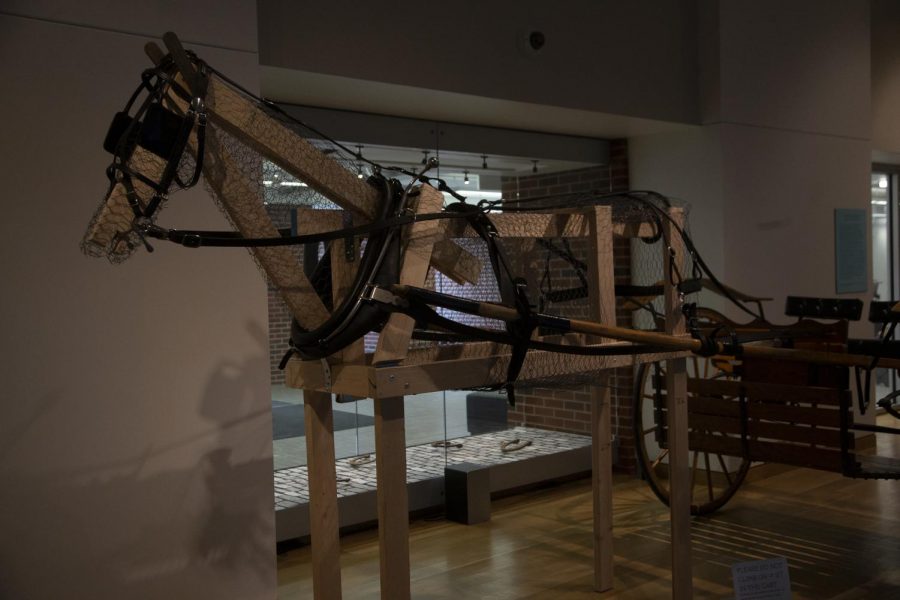“Pull of Horses” exhibit uses new tools to tell history of horses in IC
The new UI Main Library Exhibit, “The Pull of Horses,” looks into how Iowa City life was shaped around and by horses throughout history.
Pieces of The Pull of Horses exhibit in the University of Iowa’s Main Library are seen on Thursday, January 20, 2020. The Exhibit will be located in the Gallery until March 29, 2020. (Raquele Decker/The Daily Iowan)
February 3, 2020
A new University of Iowa Main Library exhibit aims to shed light and insight onto a large piece of historical development that often goes overlooked: horses.
Walking into the “Pull of Horses” installation, a large screen projects a film featuring archive images, illustrations, and footage of horses as they work alongside humans in their everyday life. Glass cases show off equestrian artifacts, images, journals, and maps of Iowa City, as a life-size horse sculpture stands post at the front of the exhibit.
For Kim Marra, a UI theater professor and exhibit curator, her interest in horses has spanned her whole life, from growing up with horses to competing as an equestrian. It was this passion that spurred her to create the exhibit with the help of digital scholarship and collections librarian Mark Anderson.
“For me, it’s been an amazing way to use new media, and combined with the material artifacts, to access more knowledge of the past,” she said. “It’s a very different approach to scholarship. I started out writing a book, but the horses pulled me in this direction, because I want to capture more fully than I could on a printed page what their size, their motions, their natures, meant to people.”
The exhibit boasts a first for the UI Main Library installations; a continuous screening of a 72-minute film on a large screen.
“Mark and I spent three and a half years making this video, which focuses primarily on New York City,” Marra said. “I’m a theater historian, and it turns out historically that the Golden Age of Broadway coincided with the Golden Age of the Horse in New York City. I wanted to explore what that relationship meant and set it in a wider context.”
RELATED: Black curators discuss ‘insiders and outsiders’ in the art world
For Anderson, this is the first exhibit he has collaborated so closely on.
“Part of my job has always been to facilitate digitizing materials to have a wider audience on the web,” he said. “Kim came to the studio about three years ago and was looking to collaborate on a video that would involve digitizing some very highly-detailed illustrations to use in the video, and so we started collaborating there and ended up with this video.”
The expansive screen the film is displayed on is intentional in its size, in effort to give exhibit-goers a sense of the horses’ true size.
Sara Pinkham, the Exhibition and Engagement Coordinator for the Main Library, said that the screening required a new feature to be installed into the room in order to support the screen.
“This exhibit is unique in that it features a 9-by-16-inch screen in the middle of the gallery. This had never been done before in the Main Library Gallery, so we needed to install tie-down loops near the ceiling in order to accommodate the screen for the film, which runs continuously during open hours,” she said. “With the help and expertise of UI engineers, facilities specialists, and Department of Theatre Arts staff, we were able to make this work beautifully.”
Pinkham said putting the exhibition together after the initial research took around four months, where the team had to do everything from finding the best ways to present the artifacts and information to digitizing the images gathered from the UI Special Collections and the State Historical Society of Iowa.
A large focus in the exhibit is on Iowa City’s very own history with horses; according to Anderson, much of the businesses in the city were dedicated to horse care, from stables to blacksmiths to veterinarians to harness makers.
One case in the exhibit features Iowa City’s famous firefighting horse duo, Snowball and Highball, who pulled the fire wagon for years before retiring together.
“This is a very poignant story about them, because one died a little bit before the other so the other mourned the partner that he had worked side by side with all those years,” Marra said. “Horses are prey animals, they run from danger. The idea that a horse would run toward a fire is really counter-intuitive; usually they can’t get away from it fast enough at the first smell of smoke. Yet fire horses knew and did their job.”



